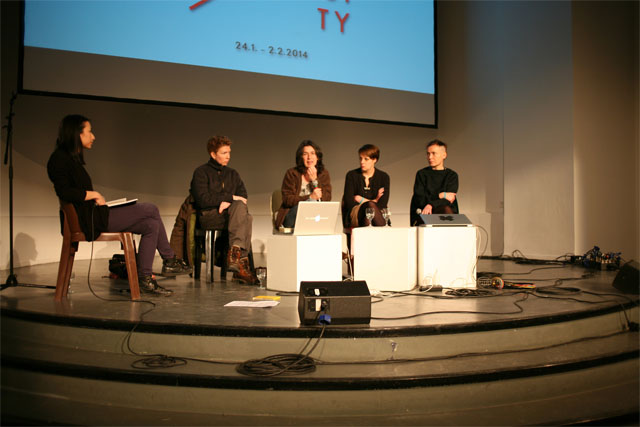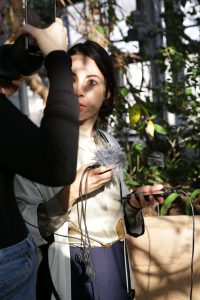A recent event as part of the CTM Festival’s discourse programme revisited and questioned the 90s cyberfeminist dream of the subversive potential inherent in technology, through talks by four panelists from across the UK and Germany –author of Ones and Zeros, Sadie Plant, artist, researcher and writer Marie Thompson, audiovisual and media designer Fender Schrade, and musician and composer Susanne Kirchmayr.
Perspectives ranged from academic reflections on cybernetics and the female voice, to the lived experience of women and transgender people in live sound engineering and electronic music. Kirchmayr is a founder of the international network of woman artists in electronic music and club culture, female:pressure. The group recently published a statistical analysis of female representation in a selection of the world’s biggest musical festivals. In the wake of that report, several mainstream publications covered the problem and the now familiar anecdotes of woman DJs and musicians experiencing sexism from male DJs or technicians began to flood in. The panel at CTM, curated by Berlin-based artist and DJ Annie Goh, aimed to diagnose the structural problems underlying this state of affairs.

Cyberfeminism emerged in the 1990s as a reaction against the male-domination of technology and a critique of second-wave feminist reinforcements of that idea (in the form of feminised ‘earth-mother’ characterisations). Instead, cyberfeminists proposed a total assimilation of the body into technology.
As Goh writes in a recent article ‘Sonic Cyberfeminism and Its Discontents’ for the CTM Festival publication, “Cyberfeminist theorists were often also net-artists, hackers and activists using art as an outlet, putting these ideas into action and co-opting the internet to explicate continued norms and prejudices.” Two decades later, the panel discussion focused around the efficacy of this approach today, and the failure of cyberfeminism to account for the role of women in sound and electronic music in particular. Events like the 2012 Her Noise symposium at the Tate Modern have attempted to probe this question but often ended by reinforcing the notion that women in sound still inhabit an exceptional role.
I spoke with Goh about the motivation behind the ‘Sound, Gender, Technology: ‘Where to’ with Cyberfeminism?’ panel and her own research on the commercialization of affect, generative art and archaeoacoustics.
How did you choose the topic and speakers for your panel?
Annie Goh: The main motivation was that CTM was one of the festivals which was dealt with by the female:pressure statistics and implicitly criticised, even though it was just data. CTM is slightly above the world average for festivals in terms of how many women or mixed acts are represented, but it’s still abysmal. Women: 8%-10%, mixed acts around 15%.
I had read an article in The Wire called ‘Invisible Women’ by Abi Bliss. She made a really good point: obviously there are too few women in electronic music but then there are pioneers like Delia Derbyshire, Daphne Oram and Éliane Radigue who are painted as heroines. This is well and good but it also serves to reinforce the mainstream narrative of the male-dominated world of electronic music, experimental music and technology. And within that then occasionally finding one cool or sexy woman we can praise as a heroine. She had an uncomfortable feeling about why it had to be this way.
The idea behind the panel was to look at the topic from a more abstract level, to investigate the structural issues and where they come from. Why is it, when you open up a magazine, audio equipment always seems to be geared towards a male consumer?
The work of Tara Rodgers was also a great influence. She gave a talk after the panel. She’s written a book called Pink Noises and she’s currently working on a feminist historiography of synthesised sound. A lot of the feminist discourse in sound studies tends to be dominated by a focus on the female voice. It’s interesting but it can get boring, if it just stops there.

Studio 1/Bethanien – © CTM/Stefanie Kulisch 2014
Marie Thompson did have some great things to say about the voice on the panel, though – dividing women’s voices in to three categories: gossips, sirens, and hi-fi wives.
AG: Yes, absolutely. And Fender Schrade’s talk was really enlightening in terms of other ways of practicing live-sound engineering. His_her practice is really in the moment, very temporal and dynamic. Sound events can’t always be met with fixed ideas concerning the space and tech needed.
Why did you interrogate cyberfeminism in particular as the focus for the panel?
AG: I guess I figured it was time for a revival. I thought it was really important to have a diverse panel to avoid a kind of dry theory conference, which ignores the existence of the real world. I thought the mixture was successful. Ideally I would have done one panel about cyberfeminism and one about sound and feminism.
The term cyberfeminism came around in the beginning of the 90s, for example with VNS Matrix – they were these Australian artists who were reacting against the exclusion of women in Internet and technology. They spread their manifesto around the web. Sadie Plant wrote Zeros and Ones, and I was really blown away by this book when I read it in my early 20s. She countered the male-domination of technology and focuses in part on Ada Lovelace, who is considered the first computer programmer, before computers were even invented.
You mentioned her book during the panel as a big influence on your own work.
AG: Yes, her book influenced the panel but also the lack of depth in the conversation (on sound, gender and technology) more generally. Cyberfeminism seemed like a good concept to hang the discussion on. There’s already been a big discussion about women and technology 20 years ago, and we wanted to talk more specifically about women in electronic music. I think 20 years is a good amount of time to start reflecting on something.
Was it the first time you co-curated the discourse programme for CTM?
AG: No, it was the second time that I curated something for the discourse programme. Last year I did the Death of Rave –a whole day event. It was a lot bigger, I had three panels: a UK panel with the CCRU [Cybernetic Culture Research Unit], theorising about the CCRU (Steve Goodman, Mark Fisher, Lee Gamble and Alex Williams, moderated by Lisa Blanning) –it was interesting to look at not only this time in the middle of the 90s in dance music culture, particularly jungle, but also how it intersected with theory. The CCRU often mention what an exhilarating time it was to be making and listening to music, but also reading and writing philosophy.
There was a Berlin panel, comparing how these themes overlapped with the fall of the Wall and the beginning of the Berlin techno scene. And then there was the ‘Virtual Futures’ panel. ‘Virtual Futures’ was a conference that took place at the University of Warwick in ’94, ’95, ’96 and then, recently, a younger guy, Luke Robert Mason, who was studying in Birmingham discovered this had been happening 20 years ago and decided to resurrect it. He and Dan O’Hara curated that panel. There was also a screening of a wonderful audiovisual work by 0rphan Drift, who remixed rave-inspired works from the 90s.
I’d like to hear a bit about your own work as an artist and electronic musician. You had a piece in the Art Hack Day event during the Transmediale 2014 Afterglow opening.
AG: Yes, my piece ‘The Banality of Affect’ was kind of inspired by the Death of Rave panels. One thing that came up in the panels was the idea of forced enjoyment these days– going to a club and feeling the imperative to have a good time. We talked a lot about the question of meaning in dance music.
The installation came out of this question of enjoyment and I was personally interested in looking at commercial trance music, like DJ Tiesto, who has insane revenue, something like $22 million a year. I watched a lot of Tiesto videos, and Armin van Buuren and all these big guys. I was interested in the euphoria that they aimed to cause with their music and whether I could generate this kind of euphoria in computer code. So through generative art, which I’ve been working on over the last three years with my professor Alberto de Campo at UdK, I am trying to synthesize sound. I wanted to generate these build-ups and drop outs that you get in trance music using data from the top five trance DJs on Twitter and five major news agencies.
So there’s good and bad news coming in and I do a mood measurement. There’s a dictionary that someone called Finn has made with thousands of words that he has given a value. ‘Amazing’ is +4 and ‘bomb’ is -3 or something. When the word ‘bomb’ comes in, there’s a code that grabs this number and, in my installation, translates this bad news into more euphoria. If the news is good – if Tiesto is saying “Amazing gig last night, Serbia!” – then the trance can be more melancholic. That will all be online very soon, I just bought the web domain, banalityofaffect.net.
Your artist name is also TranceGendy…
AG: Gendy is a principle that the composer Iannis Xenakis describes in his book Formalized Music. He wrote in French so it was Génération Dynamique Stochastique: abbreviated to Gendy. In SuperCollider there’s an object called Gendy and I used it in my live set as well.
I was checking out your piece ‘The Loss of MWA(HAHA)’ –can you tell me a bit about it?
AG: That was for the Art Hack Day event with the theme ‘Going Dark,’ this past autumn. My idea was to look at lost bits of information that never get to where they’re supposed to be. In terms of data protocol, there are protocols where you can just blindly send something and you don’t check that the message was received, so it can get lost.
This work was about the loss of protocol and the idea that there was this evil force gobbling the data, portrayed by this really hideous but fascinating object that had appeared on my stove one morning. It was a pot filled with a black, very fibrous and detailed texture. Basically, my housemate had decided to wax her legs and her mum called so she left the room, completely forgetting she had left it on the stove. The kitchen was full of smoke and the pot was black with burning wax. So I put a speaker under it and used it for the evil data gobbler.
Now that CTM is over, what’s your next project?
I’m currently working on a project on archaeoacoustics, which is a fairly recent sub-discipline within archaeology, focusing on the role of sound. For me, this brings up fascinating issues about how our visually dominated culture can be so wrong about some things!
Studies of the acoustics of archaeological sites have shown, for example, correlations between rock art and the size of resonances and echos at these points, indicating that hearing was of huge importance, much more than has previously been thought. The work of Steven J. Waller, among others, has done this, and he has pointed to echo myths all around the world.
My project is interested in these mythical meanings of echo, before science came and kind of destroyed fantasy with its explanations. Now, given our educated ears, we all know what an echo is. My question is whether we can somehow resurrect this feeling of wonder via acoustic experiences. **
















